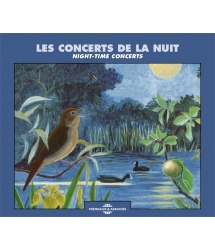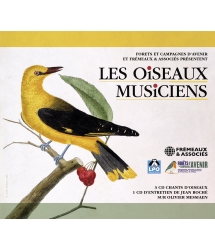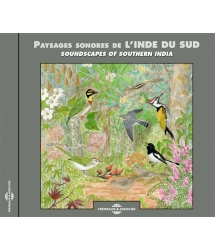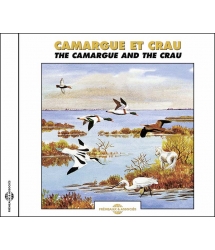- Our Catalog
- Philosophy
- Philosophers of the 20th century and today
- History of Philosophy (PUF)
- Counter-History and Brief Encyclopedia by Michel Onfray
- The philosophical work explained by Luc Ferry
- Ancient thought
- Thinkers of yesterday as seen by the philosophers of today
- Historical philosophical texts interpreted by great actors
- History
- Books (in French)
- Social science
- Historical words
- Audiobooks & Literature
- Our Catalog
- Jazz
- Blues
- Rock - Country - Cajun
- French song
- World music
- Africa
- France
- Québec / Canada
- Hawaï
- West Indies
- Caribbean
- Cuba & Afro-cubain
- Mexico
- South America
- Tango
- Brazil
- Tzigane / Gypsy
- Fado / Portugal
- Flamenco / Spain
- Yiddish / Israel
- China
- Tibet / Nepal
- Asia
- Indian Ocean / Madagascar
- Japan
- Indonesia
- Oceania
- India
- Bangladesh
- USSR / Communist songs
- World music / Miscellaneous
- Classical music
- Composers - Movie Soundtracks
- Sounds of nature
- Our Catalog
- Youth
- Philosophy
- News
- How to order ?
- Receive the catalog
- Manifesto
- Dictionnary











- Our Catalog
- Philosophy
- Philosophers of the 20th century and today
- History of Philosophy (PUF)
- Counter-History and Brief Encyclopedia by Michel Onfray
- The philosophical work explained by Luc Ferry
- Ancient thought
- Thinkers of yesterday as seen by the philosophers of today
- Historical philosophical texts interpreted by great actors
- History
- Books (in French)
- Social science
- Historical words
- Audiobooks & Literature
- Our Catalog
- Jazz
- Blues
- Rock - Country - Cajun
- French song
- World music
- Africa
- France
- Québec / Canada
- Hawaï
- West Indies
- Caribbean
- Cuba & Afro-cubain
- Mexico
- South America
- Tango
- Brazil
- Tzigane / Gypsy
- Fado / Portugal
- Flamenco / Spain
- Yiddish / Israel
- China
- Tibet / Nepal
- Asia
- Indian Ocean / Madagascar
- Japan
- Indonesia
- Oceania
- India
- Bangladesh
- USSR / Communist songs
- World music / Miscellaneous
- Classical music
- Composers - Movie Soundtracks
- Sounds of nature
- Our Catalog
- Youth
- Philosophy
- News
- How to order ?
- Receive the catalog
- Manifesto
- Dictionnary
ARDECHE - NATURAL SOUNDSCAPES
PIERRE PALENGAT
Ref.: FA669
EAN : 3661585025139
Author : FREMEAUX & ASSOCIES
Label : Frémeaux & Associés
Total duration of the pack : 1 hours 13 minutes
Nbre. CD : 1
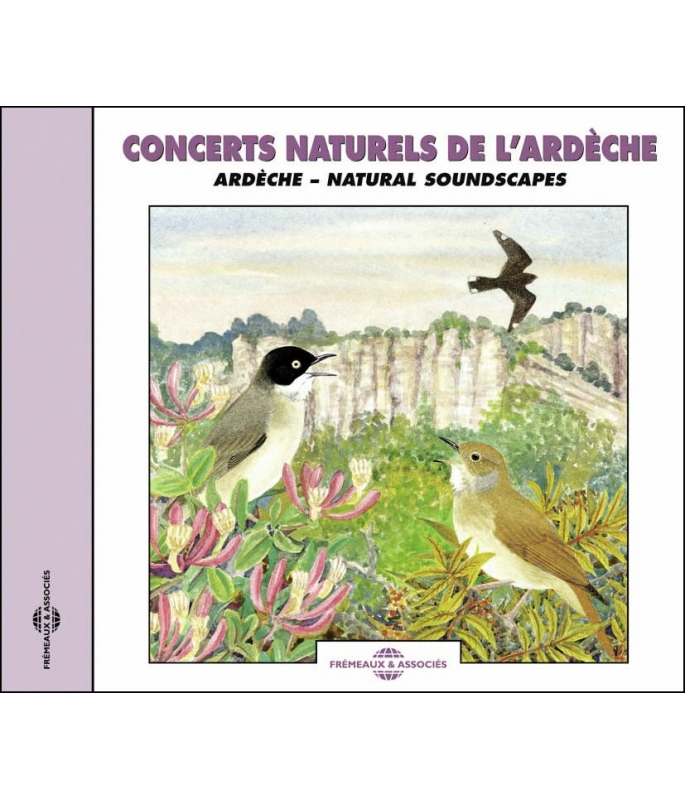
ARDECHE - NATURAL SOUNDSCAPES
ARDECHE - NATURAL SOUNDSCAPES
“With twelve concerts, this CD takes the listener on a journey through the natural landscapes of the Ardèche, in south-east France. As well as the pleasure of listening to spring concerts it’s possible to learn to identify the songs and calls of more than thirty species of birds, insects and amphibians, using the indexes and booklet. These recordings, made in the four corners of the Ardèche department, at Annonay, Aubenas, Balazuc, Darbres, Lamastre, Pranles, Saint-Michel-de-Chabrillanoux, Toulaud, Vallon-Pont-d’Arc, on mont Gerbier-de-jonc, in Païolive wood and on the side of Issarlès lake, form a sound picture of the Ardèche countryside.” Patrick Frémeaux
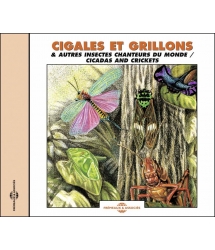
CICADAS AND CRIKETS
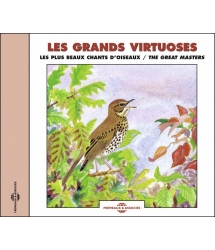
THE GREAT MASTERS VOL 1
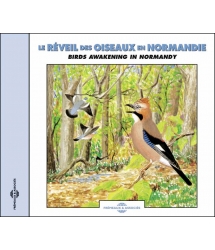
BIRDS AWAKENING IN NORMANDIE




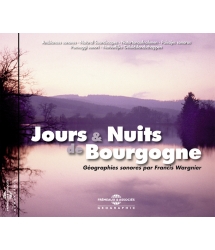
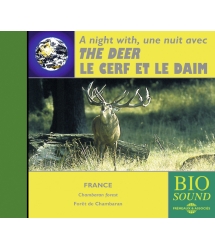
-
PisteTitleMain artistAutorDurationRegistered in
-
1Grive Musicienne (Song Thrush)Pierre PalengatPierre Palengat00:00:252007
-
2Pic Epeiche (Great Spotted Woodpecker)Pierre PalengatPierre Palengat00:04:402007
-
3Merle Noir (Bleckbird)Pierre PalengatPierre Palengat00:00:242007
-
4Grive Musicienne (Songthrush)Pierre PalengatPierre Palengat00:01:472007
-
5Merle Noir (Bleckbird)Pierre PalengatPierre Palengat00:00:372007
-
6Fauvette à Tête Noire (Blackcap)Pierre PalengatPierre Palengat00:02:122007
-
7Troglodyte Mignon (Wren)Pierre PalengatPierre Palengat00:00:272007
-
8Coucou Gris (Cuckoo)Pierre PalengatPierre Palengat00:00:332007
-
9Pic Epeiche (Great Spotted Woodpecker)Pierre PalengatPierre Palengat00:02:022007
-
10Fauvette à Tête Noire (Blackcap)Pierre PalengatPierre Palengat00:02:272007
-
11Fauvette Grise (Whitethroat)Pierre PalengatPierre Palengat00:00:442007
-
12Tourterelle des Bois (Turtle Dove)Pierre PalengatPierre Palengat00:00:292007
-
13Pouillot Véloce (Chiffchaff)Pierre PalengatPierre Palengat00:00:282007
-
14Pic Vert (Green Woodpecker)Pierre PalengatPierre Palengat00:00:432007
-
15Fauvette à Tete Noire (Clackcap)Pierre PalengatPierre Palengat00:01:092007
-
16Hypolais Polyglotte (Melodious Warbler)Pierre PalengatPierre Palengat00:03:272007
-
17Rossignol Philomèle (Nightingale)Pierre PalengatPierre Palengat00:00:322007
-
18Grand Duc d'Europe (Eagle Owl)Pierre PalengatPierre Palengat00:03:372007
-
19Fauvette Orphée (Orphean Warbler)Pierre PalengatPierre Palengat00:02:222007
-
20Rougegorge Familier (Robin)Pierre PalengatPierre Palengat00:01:452007
-
21Grive Musicienne (Song Thrush)Pierre PalengatPierre Palengat00:02:002007
-
22Serin Cini (Serin)Pierre PalengatPierre Palengat00:00:502007
-
23Loriot d'Europe (Golden Oriole)Pierre PalengatPierre Palengat00:01:562007
-
24Alouette des Champs (Slylark)Pierre PalengatPierre Palengat00:02:492007
-
25Perdrix Rouge (Red Legged Partridge)Pierre PalengatPierre Palengat00:01:012007
-
26Alouette Lulu (Woodlark)Pierre PalengatPierre Palengat00:01:412007
-
27Fauvette à Tête Noire (Blackcap)Pierre PalengatPierre Palengat00:00:202007
-
28Rossignol (Nightingale)Pierre PalengatPierre Palengat00:00:402007
-
29Sitelle Torchepot (Nuthatch)Pierre PalengatPierre Palengat00:01:392007
-
30Geai de Chênes (Jay)Pierre PalengatPierre Palengat00:01:062007
-
31Fauvette Mélanocéphale (Sardinian Warbler)Pierre PalengatPierre Palengat00:01:452007
-
32Troglodyte Mignon (Wren)Pierre PalengatPierre Palengat00:02:312007
-
33Fauvette à Tête Noire (Blackcap)Pierre PalengatPierre Palengat00:01:362007
-
34Grive Musicienne (Song Thrush)Pierre PalengatPierre Palengat00:02:042007
-
35Roitelet Huppé (Goldcrest)Pierre PalengatPierre Palengat00:00:542007
-
36Pinson des Arbres (Chaffinch)Pierre PalengatPierre Palengat00:00:442007
-
37Mésange Charbonnière (Great Tit)Pierre PalengatPierre Palengat00:01:182007
-
38Mesange à Longue Queue (Long Tailed Tit)Pierre PalengatPierre Palengat00:00:412007
-
39Rougegorge Familier (Robin)Pierre PalengatPierre Palengat00:01:422007
-
40Pouillot Véloce (Chiffchaff)Pierre PalengatPierre Palengat00:01:412007
-
41Grenouille Verte (Marsh Frog)Pierre PalengatPierre Palengat00:01:022007
-
42Rougequeue Noir (Black Redstart)Pierre PalengatPierre Palengat00:00:332007
-
43Merle Noir (Bleckbird)Pierre PalengatPierre Palengat00:01:322007
-
44Pinson des Arbres (Chaffinch)Pierre PalengatPierre Palengat00:00:392007
-
45Rossignol Philomèle (Nightingale)Pierre PalengatPierre Palengat00:02:192007
-
46Rougegorge Familier (Robin)Pierre PalengatPierre Palengat00:01:162007
-
47Martinet à Ventre Blanc (Alpine Swift)Pierre PalengatPierre Palengat00:01:052007
-
48Cigales Communes (Common Cicadas)Pierre PalengatPierre Palengat00:00:192007
-
49Guepier d'Europe (European Bee Eater)Pierre PalengatPierre Palengat00:02:022007
-
50Pinson des Arbres (Chaffinch)Pierre PalengatPierre Palengat00:02:552007
Concerts naturels de l’Ardèche
Concerts naturels de l’Ardèche
Ardèche – Natural Soundscapes
Les vedettes de ce disque sont les oiseaux. Discrets le plus souvent, qu’ils soient migrateurs ou sédentaires, c’est au printemps, saison des amours et des nids, qu’éclate leur personnalité sonore. Chacun tente alors de faire entendre son chant dans le grand concert des bois, des champs et des jardins. Le plus souvent, ce sont les mâles qui chantent, pour affirmer leur présence, attirer une compagne et défendre ensuite leur petit territoire, espace vital de la nichée.
Pierre PALENGAT
© 2004 STUDIO LES TROIS BECS - 2008 GROUPE FRÉMEAUX COLOMBINI SAS
Concerts naturels de l’Ardèche
I. Dans les bois de Toulaud (pistes 1 & 2) 5’00
II. Une châtaigneraie près de Lamastre (pistes 3 à 6) 5’00
III. Au bord d’un ruisseau, à Pranles (pistes 7 à 10) 5’30
IV. Saint-Michel-de-Chabrillanoux, lande à genêts (pistes 11 à 16) 7’00
V. Balazuc, garrigue et rossignol (pistes 17 à 19) 6’30
VI. Darbres, au bord de l’Auzon (pistes 20 à 23) 6’30
VII. Mont Gerbier-de-Jonc (pistes 24 à 26) 5’30
VIII. Bois de Païolive (pistes 27 à 31) 5’30
IX. Vallée de la Cance (pistes 32 à 34) 6’10
X. Issarlès, le tour du lac (pistes 35 à 40) 7’00
XI. Vallon-Pont-d’Arc, au bord de l’Ardèche (pistes 41 à 47) 8’30
XII. Dans une garrigue près d’Aubenas (pistes 48 à 50) 5’00
I. Dans les bois de Toulaud, près de Saint-Péray, 26 mars, 6 heures
La plupart des arbres ont encore leur silhouette hivernale, il fait presque froid, mais les bois résonnent déjà des exclamations d’une grive musicienne et des tambourinages des pics épeiches.
1. Grive musicienne. Dessus brun, ventre clair parsemé de taches brunes. Chant unique, puissant et rythmé, composé de phrases énergiques répétées 2 à 4 fois.
2. Pic épeiche. Commun dans tous les boisements, même dans les parcs et jardins. C’est le plus bigarré des pics, noir, blanc et rouge, et le plus tambourineur. On l’entend dès les premières belles journées de janvier et jusqu’à l’été. Peu doué pour le chant, le pic épeiche utilise le tambourinage pour communiquer, surtout au printemps lors des parades nuptiales. Il tambourine sur tout ce qui sonne : branches ou troncs d’arbres morts, poteaux, cheminées, volets, bois ou métal, l’important est que ça fasse du bruit ! Ici, deux pics épeiches se répondent, peut-être un couple.
Au second plan : rougegorge, troglodyte mignon, pouillot véloce, pigeon ramier.
II. Dans une châtaigneraie, entre Lamastre et Saint-Prix, 12 avril, 6 heures
Beaucoup d’oiseaux ici, qui font tout ce qu’ils peuvent pour se faire entendre dans cette cohue sonore ! Remarquer la rivalité entre les grives, les merles et les fauvettes.
3. Merle noir. Présent partout, du centre des villes au cœur des bois. C’est un très bon chanteur à la voix chaude et flûtée, qui excelle dans l’art de la mélodie et de l’improvisation.
4. Grive musicienne (voir 1). En cette saison, on l’entend pratiquement dans tous les bois. Celle-ci est particulièrement énergique !
5. Merle noir. Celui-ci, très excité, vient tenir tête à son congénère. Leurs chants se chevauchent, chacun tente de couvrir la voix de l’autre. C’est sans doute une querelle de territoire, le nouveau venu bat en retraite rapidement.
6. Fauvette à tête noire. Grise, discrète, toque noire pour le mâle, brune pour la femelle. Son chant se compose d’un habillage grinçant en sourdine suivi par une phrase forte, claire et flûtée, très musicale.
III. Au bord d’un ruisseau, à Pranles, près de Privas, 24 avril à l’aube
Des prés pentus descendent jusqu’au ruisseau, au fond d’un vallon bordé d’aulnes, de frênes et de ronces.
7. Troglodyte mignon, le bien nommé : il aime les abris, cavités, ronciers, tas de bois ou de branchages qu’il explore dans sa chasse quotidienne aux insectes ; mignon, évidemment, par sa taille minuscule. Chant puissant, énergique et très aigu.
8. Coucou gris. On entend que lui ! C’est encore un mâle qui chante pour attirer une femelle. Celle-ci ira ensuite pondre ses 12 à 15 œufs dans les nids d’autres espèces, un œuf par nid, confiant ainsi l’élevage de ses jeunes à d’autres oiseaux.
9. Pic épeiche, tambourinage (voir 2). Commun aux deux sexes, le tambourinage est un langage qui porte très loin. Pratique pour se rencontrer !
10. Fauvette à tête noire (voir 6). C’est l’époque des parades nuptiales : pour séduire la femelle, le mâle agite frénétiquement ses ailes et sa queue, les fait claquer, gonfle les plumes de sa poitrine, et tout ça en chantant !
IV. Dans une lande à genêts, Saint-Michel-de-Chabrillanoux, vallée de l’Eyrieux, 2 mai, 5 heures
Des genêts, des genévriers, des fourrés d’épineux, quelques bosquets… C’est le milieu préféré des fauvettes et des hypolaïs.
11. Fauvette grisette. Oiseau typique des landes et des friches, revenu ces jours-ci des savanes d’Afrique tropicale. Son chant est une petite strophe nerveuse, rapide et grinçante.
12. Tourterelle des bois. Petite, brune, queue noire terminée de blanc. Roucoulement doux et ronronnant.
13. Pouillot véloce. Très commun dans tous les bois. Son plumage discret jaune, vert et gris se confond avec les feuillages, mais on le reconnaît facilement à son chant sautillant : tsip-tsap-tsip-tsap- tsip-tsip-tsap…
14. Pic vert. Plumage vert, tête rouge, tambourine rarement mais se fait remarquer par ses éclats de rire très sonores.
15. Fauvette à tête noire (voir 6 et 10). Elles sont deux ici à rivaliser de jolies phrases flûtées.
16. Hypolaïs polyglotte. Petit, vert, jaune, gris, typique des broussailles ensoleillées. Son chant, qui comprend parfois des imitations, commence souvent par une répétition de notes identiques, et continue par un torrent délirant, très rapide et grinçant. Un vrai fou du chant !
V. Balazuc, près du pont du Vieil-Audon, 8 mai à l’aube
L’air est rempli d’odeur de chèvrefeuille. C’est l’heure où le grand-duc et l’engoulevent vont dormir, et celle du réveil des oiseaux des bois. Le rossignol, qui a chanté toute la nuit, reprend de la vigueur aux premières lueurs.
17. Rossignol philomèle et Engoulevent d’Europe. Ces deux-là reviennent du Sud du Sahara. Avec son plumage brun, roux, gris, le rossignol n’est pas facile à observer dans les buissons qu’il quitte rarement. Chant incomparable, très sonore et musical, riche en nuances et en inventions. L’engoulevent d’Europe, mystérieux nocturne chasseur d’insectes volants, a un plumage “camouflage” couleur feuille morte. Son chant typique est un ronronnement doux, long et monotone.
18. Grand-duc d’Europe. Le géant des hiboux : 1,80 m d’envergure. Son chant, un ou-ho grave répété toutes les 8 à 10 secondes, porte jusqu’5 kilomètres.
19. Fauvette orphée. Grande fauvette méditerranéenne qui vit dans les maquis, les vergers… Chant simple : quelques syllabes répétées d’une voix rauque.
VI. Darbres, Coiron, 18 mai à l’aube
Au bord de l’Auzon, fenouil, grandes fougères et genêts en fleurs. Bois frais de chênes, châtaigniers et acacias aux troncs couverts de lierre. Près de la cascade du village, un loriot sifflote à la cime des peupliers.
20. Rougegorge familier. Sa voix est fine et ciselée, très aiguë, douce et peu sonore. Le chant, commun aux deux sexes, est composé de phrases courtes et variées, souvent très mélodiques, un vrai plaisir.
21. Grive musicienne (voir 1 et 4). Elle chante dans les arbres de l’autre côté de la rivière. Coups de sifflets, exclamations répétées, c’est bien elle !
22. Serin cini. Cousin du canari, petit, jaune et gris. Souvent près des maisons, dans les parcs, jardins et vergers. Long babillage précipité et grinçant, peu mélodique.
23. Loriot d’Europe. Le beau siffleur, jaune et noir, de la taille d’un merle. Malgré ses couleurs vives, il est souvent invisible, haut perché dans les feuillages. Chant simple, 3 ou 4 jolies notes flûtées, facile à imiter.
VII. Mont Gerbier-de-Jonc, 25 mai, 7 heures
D’immenses prairies, des vaches, des moutons, un horizon de sucs et de sommets, nous sommes sur le toit de l’Ardèche. Le vent du nord fait onduler l’herbe des prés. Les vaches, curieuses, s’approchent de moi lentement, me regardent longuement, et menacent l’enregistrement !
24. Alouette des champs. Les Anglais l’appellent justement skylark, l’alouette du ciel. Elle s’élève à la verticale en chantant, se laisse pousser par le vent, volette ainsi un long moment sans cesser de chanter et se laisse tomber comme une pierre, sans doute près de son nid. Chant intarissable et très rapide, plein d’invention, un flux continu de notes aiguës et de trilles contenant parfois des imitations.
25. Perdrix rouge. Tchouk-tchouk-tchoukar, tic-tic-tic-tic-tic… Celle-ci passe assez loin, le long d’une haie. Tant mieux, sa voix n’est pas très agréable.
26. Alouette lulu. Elle doit son nom à son chant, composé de variations et d’improvisations sur le thème lulu-di-lulu, série de notes très pures, descendantes et mélancoliques. Celle-ci chante en vol, une merveille !
VIII. Bois de Païolive, près des Vans, 30 mai, 5 heures
L’ambiance est un peu magique ce matin. Une brume légère s’attarde au-dessus des bois, je déambule entre les rochers et les bosquets dans un calme étrange.
27. Fauvette à tête noire (voir 6 et 10). Son chant, toujours clair et flûté, est sujet à des variations locales. Ici, par exemple, le dialecte de Païolive.
28. Rossignol, cris (voir 17). Autant son chant est agréable, autant son cri est rauque !
29. Sittelle torchepot. Petit oiseau typique des bois de chênes, dessus gris, ventre clair teinté de roux. Très vive et remuante, elle arpente les branches et les troncs en tous sens, et même la tête en bas ! Ici, ses cris rappellent le bruit d’une vieille machine à écrire.
30. Geai des chênes. Beau corvidé au plumage bigarré gris-rose, noir, blanc, avec de jolies plumes bleues sur les ailes, grand consommateur de glands. Cris aigres et très sonores.
31. Fauvette mélanocéphale. Grise, tête noire, œil cerclé de rouge, typique des maquis secs et des fourrés d’épineux. Elles sont 3 ou 4, très mobiles ; je les suis à travers les buissons d’où elles lancent leurs petites strophes grinçantes.
IX. Vallée de la Cance, près d’Annonay, 3 juin à l’aube
Vallée profonde et verte aux parois abruptes couvertes de chênes, d’acacias, de buis et de pins sylvestres. Un sentier en sous-bois descend au bord de l’eau.
32. Troglodyte mignon (voir 7). Pour être mieux entendu, celui-ci lance son chant depuis les hautes branches d’un peuplier. Strophes stridentes et claires, pleines d’énergie, répétitives. Un engoulevent ronronne au second plan.
33. Fauvette à tête noire (voir 6, 10 et 27). Elle est partout, et toujours aussi bavarde !
34. Grive musicienne (voir 1, 4 et 21). Perchée à la cime d’un arbre, bien en vue, elle lance inlassablement ses puissantes exclamations qui résonnent à plusieurs centaines de mètres.
X. Issarlès, le tour du lac, 8 juin, 5 heures
La nuit à la belle étoile fut bien fraîche au bord du lac, à 1 300 mètres d’altitude. Beaucoup d’arbres majestueux ici, hêtres, pins sylvestres, épicéas, peupliers géants. A l’aube, le vent agite la surface du lac, de petites vagues viennent s’échouer sur le rivage.
35. Roitelet huppé. Le plus petit oiseau d’Europe. Il doit son nom – le petit roi – à la couronne de plumes dorées qui orne sa tête. Son chant, ténu, est à son échelle : un mince si-i, si-i, si-i, siii…
36. Pinson des arbres. Commun dans tous les types de boisements. Ventre roux, dessus de la tête gris bleu, des bandes blanches sur les ailes. Son chant est une ritournelle descendante et répétitive.
37. Mésange charbonnière. Ti-tata-ti, tata-ti, tata-ti ! Un des oiseaux les plus communs des bois et des jardins. Tête noire, joues blanches, ventre jaune et cravate noire. Chant répétitif, clair et rythmé.
38. Mésange à longue queue. Une petite boule de plumes blanches et noires piquée d’une longue queue. Souvent en bandes, se reconnaît à ses petits cris incessants : si-si-si-si, tsriii, tsriii…
39. Rougegorge familier (voir 20). Il est commun partout où il y a des buissons et quelques arbres, de la plaine à la montagne.
40. Pouillot véloce (voir 13). Lui aussi niche partout en Ardèche, dans les forêts de feuillus, les haies, les bosquets…
XI. Au bord de l’Ardèche, en aval du Pont-d’Arc, 13 juin, 5 heures
Les touristes, rares en cette saison, dorment encore dans leurs tentes ou leurs camping-cars, bercés par le chant des oiseaux et les discussions des grenouilles.
41. Grenouille verte (rieuse). Jolie grenouille d’une dizaine de centimètres de longueur. Celle-ci reste invisible, cachée dans la végétation de la rive.
42. Rougequeue noir. Commun dans les villes et les villages, ici dans son milieu naturel : les rochers, les falaises… Son chant est une sorte de tiirititi pointu suivi d’un bruit de papier froissé.
43. Merle noir (voir 3 et 5). Se reconnaît de loin à sa voix chaude, calme et flûtée.
44. Pinson des arbres (voir 36). Une strophe descendante, assez forte et répétée inlassablement.
45. Rossignol philomèle (voir 17 et 28). Souvent au bord de l’eau, même s’il fréquente aussi des milieux plus arides. Il aime les buissons, les taillis, une végétation basse et dense où il peut se dissimuler.
46. Rougegorge familier (voir 20 et 39). Entre ses phrases de dentelle improvisées, le rougegorge écoute les réponses de ses voisins.
47. Martinet à ventre blanc ou martinet alpin. Ils sont toute une bande tournoyant au-dessus de l’eau. Plus grand, plus montagnard et méditerranéen que le très urbain martinet noir. Vit en colonies dans les falaises, les gorges. Ses cris, en chœur et en vol, rappellent un rire aigu et cliquetant.
XII. Dans une garrigue, près d’Aubenas, 3 juillet, 11 heures
Il fait déjà chaud, les cigales sont invisibles mais nombreuses dans ces bosquets de chênes verts. Leur concert baisse d’intensité au passage d’un petit troupeau de chèvres suivi par un jeune berger en VTT.
48. Cigales communes. Vraiment très bruyantes, et très prudentes : leur crépitement cesse à la moindre alerte. Ce sont encore des mâles qui chantent pour attirer les femelles…
49. Guêpier d’Europe. Ils virevoltent au loin en lançant leurs cris typiques : cruc-cruc-cruc-cruic-cruic… Plumage multicolore magnifique : vert, jaune, brun, bleu turquoise.
50. Pinson des arbres (voir 36). Un des derniers oiseaux à chanter encore en ce début d’été.
Pierre PALENGAT
© 2004 STUDIO LES TROIS BECS - 2008 GROUPE FRÉMEAUX COLOMBINI SAS
Merci à la Frapna (Fédération Rhône-Alpes de protection de la nature)
Enregistrements, réalisation et textes : Pierre Palengat
Index :
1. Grive musicienne / Song Thrush
2. Pic épeiche / Great Spotted Woodpecker
3. Merle noir / Blackbird
4. Grive musicienne / Song Thrush
5. Merle noir / Blackbird
6. Fauvette à tête noire / Blackcap
7. Troglodyte mignon / Wren
8. Coucou gris / Cuckoo
9. Pic épeiche / Great Spotted Woodpecker
10. Fauvette à tête noir / Blackcap
11. Fauvette grisette / Whitethroat
12. Tourterelle des bois / Turtle Dove
13. Pouillot véloce / Chiffchaff
14. Pic vert / Green Woodpecker
15. Fauvette à tête noire / Blackcap
16. Hypolaïs polyglotte / Melodious Warbler
17. Rossignol philomèle et engoulevent d’Europe / Nightingale and Nightjar
18. Grand-duc d’Europe / Eagle Owl
19. Fauvette orphée / Orphean Warbler
20. Rougegorge familier / Robin
21. Grive musicienne / Song Thrush
22. Serin cini / Serin
23. Loriot d’Europe / Golden Oriole
24. Alouette des champs / Skylark
25. Perdrix rouge / Red-legged Partridge
26. Alouette lulu / Woodlark
27. Fauvette à tête noire / Blackcap
28. Rossignol, cris / Nightingale, call
29. Sittelle torchepot / Nuthatch
30. Geai des chênes / Jay
31. Fauvette mélanocéphale / Sardinian Warbler
32. Troglodyte mignon / Wren
33. Fauvette à tête noire / Blackcap
34. Grive musicienne / Song thrush
35. Roitelet huppé / Goldcrest
36. Pinson des arbres / Chaffinch
37. Mésange charbonnière / Great Tit
38. Mésange à longue queue / Long-tailed Tit
39. Rougegorge familier / Robin
40. Pouillot véloce / Chiffchaff
41. Grenouille verte (rieuse) / Marsh Frog
42. Rougequeue noir / Black Redstart
43. Merle noir / Blackbird
44. Pinson des arbres / Chaffinch
45. Rossignol philomèle / Nightingale
46. Rougegorge familier / Robin
47. Martinet à ventre blanc / Alpine Swift
48. Cigales communes / Common Cicadas
49. Guêpier d’Europe / European Bee-eater
50. Pinson des arbres / Chaffinch
english notes
Introduction
The stars of this CD are the birds. Often discreet, whether migrants or residents, it’s in the spring when looking for a mate and nesting that the different species’ songs are at their height. Each bird then tries to make itself heard above the general chorus in woods, fields and gardens. More often than not it’s the male that sings, to affirm his presence, attract a mate and then defend his small territory, his vital living space.
Pierre PALENGAT
© 2004 STUDIO LES TROIS BECS - 2008 GROUPE FRÉMEAUX COLOMBINI SAS
Natural concerts from the Ardèche
I. In Toulaud wood (tracks 1 & 2) 5’00
II. A Sweet Chestnut wood near Lamastre (tracks 3 to 6) 5’00
III. On the banks of a stream, at Pranles (tracks 7 to 10) 5’30
IV. A broom heath, Saint-Michel-de-Chabrillanoux (tracks 11 to 16) 7’00
V. A Nightingale in garrigue, Balazuc (tracks 17 to 19) 6’30
VI. On the banks of the Auzon, Darbres (tracks 20 to 23) 6’30
VII. Mont Gerbier-de-Jonc (tracks 24 to 26) 5’30
VIII. Païolive wood (tracks 27 to 31) 5’30
IX. The Cance valley (tracks 32 to 34) 6’10
X. Around the lake, Issarlès (tracks 35 to 40) 7’00
XI. On the banks of the Ardèche, Vallon-Pont-d’Arc (tracks 41 to 47) 8’30
XII. In garrigue, near Aubenas (tracks 48 to 50) 5’00
I. In Toulaud wood, near Saint-Péray, 26th March, 6 o’clock in the morning
Most of the trees are still without leaves, it’s almost cold, but the wood is already vibrating with a Song Thrush’s song and the drumming of Great Spotted Woodpeckers.
1. Song Thrush. Brown above, pale underparts spotted brown. A characteristic song, loud and rhythmic, composed of energetic phrases repeated 2, 3 or 4 times.
2. Great Spotted Woodpecker. Common in all wooded areas, even in parks and large gardens. It’s the most striped woodpecker, black, white and red, and the one that drums the most. It can be heard from the first fine days of January until summer. Not at all a songster, the Great Spotted Woodpecker uses drumming to communicate, especially when displaying in spring. They will drum on almost anything hollow: truck or branch of a dead tree, telegraph pole, chimney, and even wooden or metal shutters, just so long as they make a noise! Here, two woodpeckers reply to each other, maybe a pair.
In the background: Robin, Wren, Chiffchaff and Wood Pigeon.
II. In a Sweet Chestnut wood, between Lamastre and Saint-Prix, 12th April, 6 o’clock in the morning
Lots of birds here, all doing their best to make themselves heard in the cacophony of sounds. Notice the rivality between Blackbirds, thrushes and warblers.
3. Blackbird. Present almost everywhere, in the centre of large cities and the heart of woodlands. It’s a very good songster with a warm, fluty voice, very melodious and an excellent improviser.
4. Song Thrush (see 1). At this time of year it can be heard in almost any wood. The one here is particularly energetic!
5. Blackbird. This one, very excited, is facing up to a rival. Their songs overlap, each bird trying to drowm out the others song. It’s probably a territorial conflict, the newcomer leaving rapidly.
6. Blackcap. Grey, discreet, male with a black cap, the female a brown one. It’s song is composed of scratchy warbling followed by a short, very musical, clear, fluty phrase.
III. On the banks of a stream, at Pranles, near Privas, 24th April at dawn
Steep meadows slope down to the stream in the bottom of a valley bordered with alders, ash and bramble.
7. Wren. The popular diminutive wren is forever searching out it’s insect food in hidden corners. It has a loud, energetic, high-pitched song.
8. Cuckoo. It’s hard not to hear, the male again singing to attract a female. She then lays between 12 and 15 eggs in other birds’ nests, one per nest, thus leaving other species to rear its young.
9. Great Spotted Woodpecker, drumming (see 2). Both sexes perform the far-carrying drumming. A practical way of finding each other.
10. Blackcap (see 6). It’s a time for displaying: to attract a female the male frantically flutters its wings and tail, clapping them, ruffling its breast feathers and all the time singing.
IV. A broom heath, Saint-Michel-de-Chabrillanoux, the Eyrieux valley, 2nd May, 5 o’clock
Groups of broom, juniper, thorn thickets and a few stands of trees… A habitat favoured by many warblers.
11. Whitethroat. A species typical of heaths and scrub, recently arrived from tropical Africa. Its song is a short nervous phrase, quick scratchy.
12. Turtle Dove. Small, brown, black tail with a white tip. A soft, purring coo.
13. Chiffchaff. Common in nearly every woodland. Its discreet greyish yellow-green plumage blends in well with the foliage but it is easily found when giving its very distinctive chiff-chaff-chiff-chaff-chiff-chiff-chaff… song.
14. Green Woodpecker. Green with red on the head, it rarely drums but often gives bouts of its loud laughing call, the yaffle.
15. Blackcap (see 6 and 10). Here two rivals sing pretty, fluty phrases.
16. Melodious Warbler. A small greyish yellow-green bird common in sunny scrub. Its song, sometimes containing imitations, often starts with a repetition of the same note followed by a rapid cascade of scratchy notes. A crazy songster!
V. Balazu, near the Vieil-Audon bridge, 8th May at dawn
The air is full of the scent of honeysuckle. It’s the hour of the morning that the Eagle Owl and Nightjar go to roost, when other birds are waking-up. The Nightingale, that’s being singing for most of the night, is even more energetic at this hour.
17. Nightingale and Nightjar. Both return from over-wintering in sub-Saharan Africa. The brown, rufous and grey Nightingale is hard to see hiding in the dense undergrowth that it rarely leaves. Its unique resounding, musical song is full of subtle changes and inventions. The Nightjar, a mysterious nocturnal insect hunter has a very cryptic plumage, the colour of dead leaves. It has a characteristic long and monotonous reeling song.
18. Eagle Owl. A giant amongst owls with a 5 foot wingspan. Its low ou-ho call is repeated every 8 to 10 seconds and can carry up to 5 kilometres.
19. Orphean Warbler. A large Mediterranean warbler that inhabits maquis, orchards… It has a simple song, a few repeated low, hoarse notes.
VI. Darbres, Coiron, 18th May at dawn
On the banks of the Auzon there’s fennel, high bracken and flowering broom. Nearby a shady wood with ivy-covered oak, sweet chestnut and acacia. A Golden Oriole whistles form the top of a polar near the waterfall in the village.
20. Robin. Its call clear, precise, high-pitched, soft but not particularly musical. The song, given by both sexes, is a musical composition of short, varied phrases, a real delight.
21. Song Thrush (see 1 and 4). It’s singing from the trees on the other side of the river. Bouts of whistling often repeated; it’s a Song Thrush!
22. Serin. A small yellow and grey cousin of the domestic canary. It’s often found near houses, in gardens, parks and orchards. A long and rapid unmusical scatchy song.
23. Golden Oriole. A stunning blackbird-sized black and yellow bird with a melodious whistle. Despite its bright colours it can be very hard to locate in the treetop foliage. A simple 3 or 4 note whistled song, easy to imitate.
VII. Mont Gerbier-de-Jonc, 25th May, 7 o’clock
Immense meadows with cows, sheep, and hill-tops, we’re at the height of Ardèche. The northerly wind ripples the grass. The cows, curious, approach me slowly; then take a long look, maybe spoiling the recording.
24. Skylark. A very appropriate name, it flies skywards whilst singing, going with the wind for a while still singing then suddenly dropping like a stone to the ground, probably landing close to its nest. Its never-ending, untiring song is full of invention, a continual flow of high-pitched trilling, with the occasional imitation.
25. Red-legged Partridge. Tchouk-tchouk-tchoukar, tic-tic-tic-tic-tic… Not too close, on the other side of a hedge; not a particularly musical “song”.
26. Woodlark. It inhabits more wooded habitats than the skylark; thus its name. It’s song includes variants and improvisations on a lulu-di-lulu (from which it acquire its Latin name) theme; a series of pure, descending, melancholic notes. A marvellous rendition in flight.
VIII. Païolive wood, near Vans, 30th May, 5 o’clock
A slightly magic atmosphere this morning. A light mist hangs over the wood. I wander between rocks and copses in a strange silence.
27. Blackcap (see 6 and 10). Its song, always clear and fluty, contains local variations; here for example is the Païolive dialect.
28. Nightingale, call (see 17). In contrast to its musical song, its call is hoarse.
29. Nuthatch. A small grey-backed, orange-breasted bird typical of oak woodland. Lively and active and it climbs up and down branches and trunks sometimes even upside-down. Here, its calls are somewhat reminiscent of an ancient type-writer.
30. Jay. A beautiful multicoloured member of the crow family, greyish-pink, black and white with some striking blue feathers on the wing; it’s very found of acorns. The calls are sharp and loud.
31. Sardinian Warbler. Grey overall with black head and red circle round the eye, typical of dry maquis and thorn scrub of southern Europe. Here there’re 3 or 4 very active birds; I followed them through the bushes as they gave their short, squeaky phrases.
IX. The Cance valley, near Annonay, 3rd June at dawn
A deep, green, steep-sided valley full of oak, acacia, box and Scots pine. A path follows the stream through the under-storey.
32. Wren (see 7). To be better heard this birds giving its song from the top of a poplar. Strident, clear repeated phases, full and energy. There’s a nightjar churring in the background.
33. Blackcap (see 6, 10 and 27). It’s everywhere, and always as noisy!
34. Song thrush (see 1, 4 and 21). Perched on the very top of a tree, in full view, it untiringly pours out its loud song, audible several hundred yards away.
X. Issarlès, a tour of the lake, 8th June, 5 o’clock
Outside, the night is cool at the waters edge, at an altitude of 1300 metres. Many majestic trees here, beeches, Scots pines, spruces, large poplars. At dawn the wind ruffles the lake surface and small waves break on the shore.
35. Goldcrest. The smallest European bird. Its name comes from the bright yellow and orange feathers on the crown. Its precise song is in relation to its size: a thin si-i,si-i,si-i,siii…
36. Chaffinch. Common wherever there’re trees; Pink breast, grey-blue top to the head and white wing-bars; it’s a male Chaffinch. Its song is a descending repetitive phrase.
37. Great Tit. Ti-tata-ti, tata-ti, tata-ti-! One of the commonest woodland and garden birds; a black head with white cheeks, yellow belly with a black tie. Its song is clear, rhythmic, and repetitive.
38. Long-tailed Tit. A small ball of black, white and pink feathers on the end of a long tail. Often in a flock, easy found as they call incessantly: si-si-si-si, tsriii, tsriii…
39. Robin (see 20). Common almost everywhere there are bushes are a few trees, from sea-level to mountains.
40. Chiffchaff (see 13). Another species that’s present all over the Ardèche, in deciduous woodland, hedgerows, copses…
XI. On the banks of the Ardèche, below Pont-d’Arc, 13th June, 5 o’clock
Tourists, rare at this time of year, are still sleeping in their tents and camping-cars, lulled by the bird song and frogs calling.
41. Marsh Frog (Green Frog group). An attractive frog, up to 4 inches long. This one stays out of sight, hidden in the riverside vegetation.
42. Black Redstart. Common in towns and villages, here it’s in its natural habitat: rocks and cliffs. Its song’s a sort of shrill tiirititi followed by the sound of crumpling paper.
43. Blackbird (see 3 and 5). Identified from afar by its calm, fluty, rich voice.
44. Chaffinch (see 36). A descending phrase, quite loud and incessantly repeated.
45. Nightingale (see 17 and 28). Often found near water, although it also inhabits dry areas. It likes bushes, scrub; dense low vegetation in which to hide.
46. Robin (see 20 and 39). Between its improvised phrases, this Robin’s listening for replies from its neighbours.
47. Alpine Swift. There’s a flock circling over the water. This species occurs at higher altitude and is more Mediterranean than the very urban Common Swift. It breeds in colonies in gorges and ion cliffs. Its calls, in chorus in flight, are like a high-pitched, jingling laugh.
XII. In a garrigue, near Aubenas, 3rd July, 11 o’clock
It’s already hot, cicadas are invisible but numerous in the clumps of holm oak. Their song diminishes with the passage of a small group of goats followed by a young goatherd on his mountain bike.
48. Common Cicadas. Very noisy, yet very wary: their clicking stops at the least sign of danger. Once again it’s the males that sing to attract females…
49. European Bee-eater. They’re turning in flight in the distance giving their typical call: cruc-cruc-cruc-cruic-cruic… they have a magnificent multicolour plumage: green, yellow, brown and turquoise blue.
50. Chaffinch (see 36). One of the last birds still singing in early summer.
Pierre PALENGAT
Translated in English by Tony WILLIAMS
© 2004 STUDIO LES TROIS BECS - 2008 GROUPE FRÉMEAUX COLOMBINI SAS
Thanks to Frapna (Fédération Rhône-Alpes de protection de la nature)
Recordings, production and text: Pierre Palengat
CD Concerts naturels de l’Ardèche © Frémeaux & Associés / Droits audio : Frémeaux & Associés - La Librairie Sonore (Producteur initial : Sittelle, Pithys, Collection Allain Bougrain Dubourg ou Ceba) / Ecouter les chants d'oiseaux sur CD : Sons et ambiances naturelles des écosystèmes - Stéreo and digital recording of the natural landscape sound. Natural sound sceneries of écosystems, Voices of the Wild Life. Les droits de cet enregistrement sont protégés par la loi. Pour toute exploitation d’illustration sonore sur CD, DVD, CD-Rom, Télévision, Cinéma, Sites internet, scénographies (théâtre, musées…), l’autorisation et un devis gratuit peuvent être obtenus auprès de Frémeaux & Associés – fax : +33 (0)1 43.65.24.22 info@fremeaux.com
